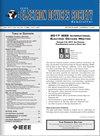Design of an Integrated MEMS Magnetic Gradiometer Rejecting Vibrations and Stray Fields
IF 2
3区 工程技术
Q3 ENGINEERING, ELECTRICAL & ELECTRONIC
引用次数: 0
Abstract
Magnetic sensors are often used near current-carrying wires or electrical motors generating significant magnetic interference. To mitigate the effects of these stray fields, the traditional design approach relies on a differential sensing scheme: multiple magnetometers are spaced apart, and the field differences are measured. Despite being rejected, stray fields still constrain the design space. Extra linear range and matched channels are required to accommodate their peak amplitude without saturation or residual common-mode leakage. On the contrary, single-point MEMS gradiometers rely on the force acting on a magnet, which is directly proportional to the magnetic field gradient. The stray field is intrinsically rejected by the magnetic transducing mechanism, even before entering the measurement chain. The range of the measurement chain can then be largely optimized for the gradient, independently of the stray field amplitude. This paper discusses the design of a single-point MEMS gradiometer. By design, it rejects magnetic stray fields and mechanical disturbances like vibrations and gravity. It is the first single-point MEMS gradiometer capable of operating unshielded and in various orientations. The prototype achieves a noise density of 4 nT/mm/抑制振动和杂散场的集成MEMS磁梯度计设计
磁传感器常用于产生显著磁干扰的载流导线或电动机附近。为了减轻这些杂散场的影响,传统的设计方法依赖于差分传感方案:将多个磁力计分开,并测量磁场差异。尽管被拒绝,杂散场仍然限制了设计空间。需要额外的线性范围和匹配的通道来容纳它们的峰值幅度,而没有饱和或剩余的共模泄漏。相反,单点MEMS梯度仪依赖于作用在磁铁上的力,这与磁场梯度成正比。杂散场在进入测量链之前就被磁换能器固有地抑制了。然后,测量链的范围可以根据梯度进行很大程度的优化,而与杂散场振幅无关。本文讨论了单点MEMS梯度仪的设计。通过设计,它可以排除磁场杂散和机械干扰,如振动和重力。它是第一个能够在无屏蔽和各种方向上工作的单点MEMS梯度仪。该样机在${\pm } 300~{\mu }$ T/mm的测量范围内实现了4 nT/mm/ $\sqrt {\mathrm { Hz}}$的噪声密度。本文验证了该传感器在母线电流传感中的有效性。本文还概述了设计的局限性和未来的设计前景。
本文章由计算机程序翻译,如有差异,请以英文原文为准。
求助全文
约1分钟内获得全文
求助全文
来源期刊

IEEE Journal of the Electron Devices Society
Biochemistry, Genetics and Molecular Biology-Biotechnology
CiteScore
5.20
自引率
4.30%
发文量
124
审稿时长
9 weeks
期刊介绍:
The IEEE Journal of the Electron Devices Society (J-EDS) is an open-access, fully electronic scientific journal publishing papers ranging from fundamental to applied research that are scientifically rigorous and relevant to electron devices. The J-EDS publishes original and significant contributions relating to the theory, modelling, design, performance, and reliability of electron and ion integrated circuit devices and interconnects, involving insulators, metals, organic materials, micro-plasmas, semiconductors, quantum-effect structures, vacuum devices, and emerging materials with applications in bioelectronics, biomedical electronics, computation, communications, displays, microelectromechanics, imaging, micro-actuators, nanodevices, optoelectronics, photovoltaics, power IC''s, and micro-sensors. Tutorial and review papers on these subjects are, also, published. And, occasionally special issues with a collection of papers on particular areas in more depth and breadth are, also, published. J-EDS publishes all papers that are judged to be technically valid and original.
 求助内容:
求助内容: 应助结果提醒方式:
应助结果提醒方式:


